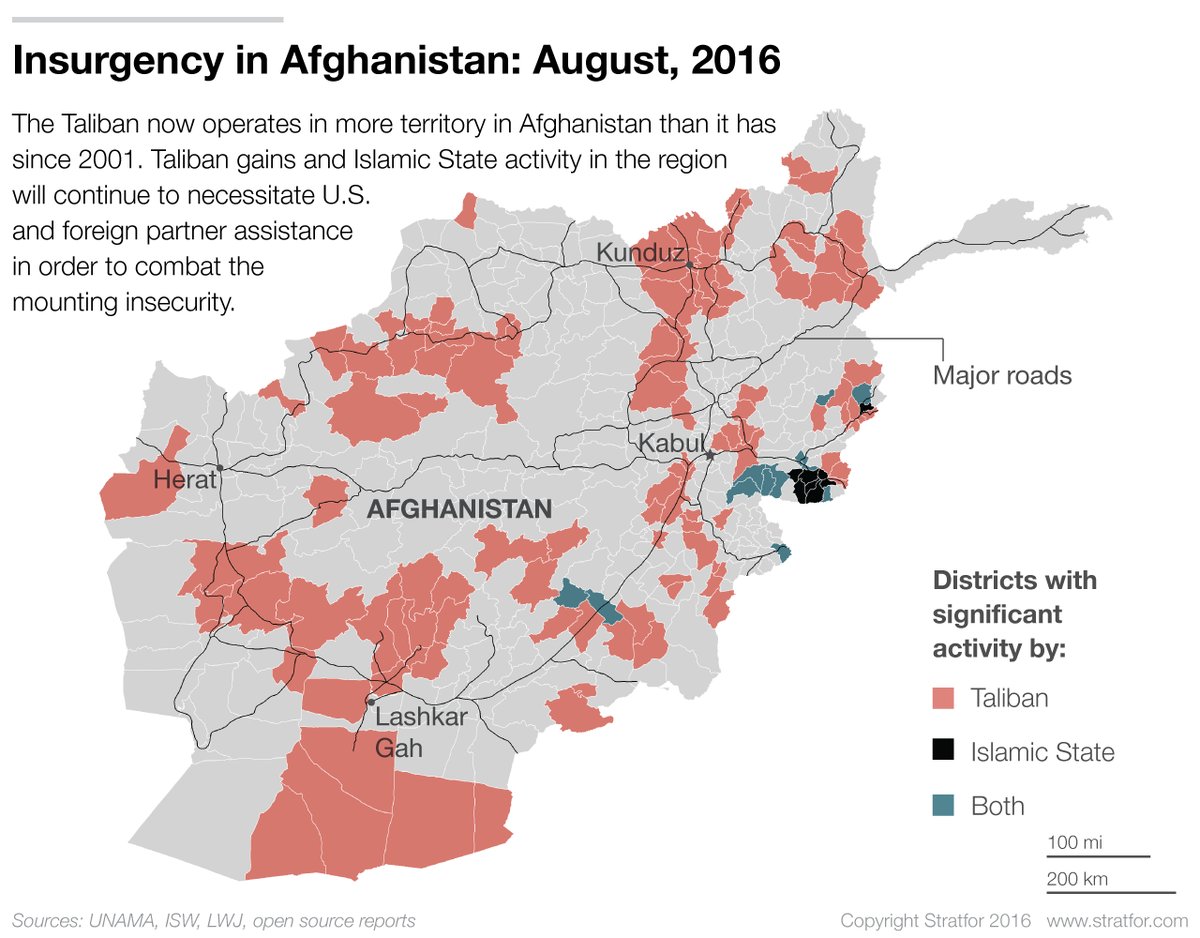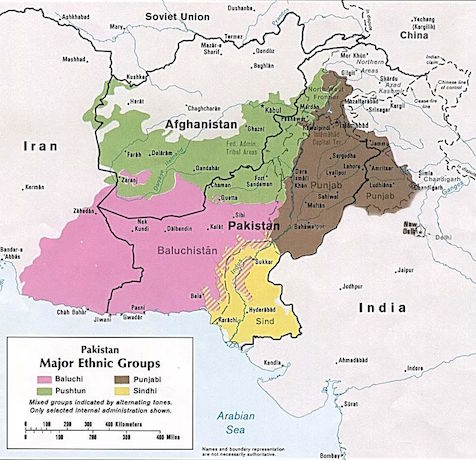What has been the most frustrating foreign venture for the United States? Iraq was very big but solvable and, for all practical purposes, it has been solved. Syria loomed very large a year or two ago. But today it seems somewhat capable of a solution especially with the Trump administration planning to cooperate with Russia & Turkey. The bulk of the carnage is behind us and, while the memories of that are horrific, the future seems somewhat manageable.
No, the most frustrating foreign venture has been and continues to be Afghanistan. No one in America wants to be there but no one, not even the most inward-looking person in the Trump Administration, wants to leave. The fear, of course, is of repeating the mistake of leaving Iraq in 2011 & the resultant political stigma. The War on Terror began in Afghanistan as a response to 9/11 attack on the World Trade Center. Departure in defeat from Afghanistan would be an admission of losing that war, something far more emotionally devastating than the defeat in Vietnam.
Because Vietnam was a local defeat and the ramifications were restricted to Vietnam & only to Vietnam. A defeated exit from Afghanistan would be a global defeat and an extremely momentous one, not unlike the exit in defeat of Soviet Union from Afghanistan.
The exit of America will either lead very fast to the reestablishment of the Taleban regime, a worse Taleban than the one in mid-1990s one, or a Syria like inter-ethnic war between the Pushtun Taleban and the minority Tajik, Uzbek & even Shia Hazara militias (already in training by Iran) with sides picked opportunistically by Russia & possibly China.
So an American exit is out of question & the best alternative for now is maintaining a semblance of a low-intensity conflict based order in Afghanistan. Keeping Afghanistan out of news by keeping it out of an immediate crisis is the near term objective.
That is harder said than done because the American-kept Afghan government is staring at the abyss. These words were used by Kamran Bukhari of Geopolitical Futures less than six months ago in October 2016. What is the abyss?
 Why bring this up now? Secondarily because the winter will lead to spring soon and snow-covered mountain passes will become usable. Fighters from Taleban sanctuaries across the Af-NaPak line of control could enter Afghanistan more easily to add to the 57% of Afghanistan they already control.
Why bring this up now? Secondarily because the winter will lead to spring soon and snow-covered mountain passes will become usable. Fighters from Taleban sanctuaries across the Af-NaPak line of control could enter Afghanistan more easily to add to the 57% of Afghanistan they already control.
And primarily because of what General John Nicholson, top U.S. Commander in Afghanistan, told the Senate Armed Services Committee this Thursday. He said he was “short a few thousand troops” for his mission and he asked for a “holistic review” of America’s relationship with NaPakistan.
1. Insanity
What reason did General Nicholson give for his need for a few thousand more troops? Because “the 8,400 U.S. troops in Afghanistan, with another 5,000 troops deployed by NATO allies, are unable to break the stalemate” in Afghanistan. Why not? Because “they’re not able to train enough Afghan forces“.
Haven’t we learned anything from the enormous amount of money spent in Iraq training the Iraqi Army only to see them collapse & run from ISIS attacks less than two years ago? Aren’t we re-learning an old lesson in the so far successful attack on Mosul by the Iraqi Army?
The lesson is simple. Iraqi forces & Afghan forces do well only when they are led by American troops in battle with American air support. They fight skillfully & bravely under American military direction & American air power. You take away American forces from leadership in battle and what happens? The Afghan forces begin losing battles and surrendering large swaths of territory to Taleban militias. Just look at the above Stratfor map from August 2016.
So this need to “train Afghan forces” is hogwash. General Nicholson needs several thousand troops to attack the Taleban with Afghan government forces & remove them from the areas they currently control in Afghanistan. Yes, this can be done. And then what? The Taleban will return when the American troops get reassigned to different provinces or leave; the Afghan forces will retreat or surrender and the Taleban will win back control of the previously cleansed provinces.
What is the other reason for this stalemate according to Gen. Nicholson?
- “Nicholson said part of the reason for the impasse are the “safe havens and external support,” the Taliban receives from Pakistan and the powerful Haqqani network, which operates on both sides of the Afghan/Pakistan border. At the same time, he said, the Taliban have morphed into a “narco-insurgency,” raking in millions of dollars harvesting and selling heroin, smuggling goods, kidnapping, and extortion”
Ah, the P-word. That brings it to a greater state of insanity. The endless discussion over decades of how America can “persuade” NaPakistan to change its ways & see things the American way. Witness the joke of this week – a new (& un-improved) report by the Hudson Institute “scholars” on how America should readjust its relationship with NaPakistan. Talk about the epitome of “scholarly insanity” or “intellectual idiocy” to paraphrase a term of Nassim Taleb.
This Hudson report reminded us of the report produced in 2009 by Alyssa Ayres & her team at the start of the Obama Administration.We attended the launch of this “report” at Asia Society and expressed our disappointment at the absence of historic, geopolitical or strategic insights in that report. Ms. Ayres went on to serve as the US deputy assistant secretary of state from 2010-2013 for the Indian Subcontinent (including Afghanistan). Predictably, the Obama surge in Afghanistan did not achieve anything but merely ephemeral results and so 7 years later we have another report from another set of ‘scholars” at another US think-tank. Insanity!
These “scholars” fail because they refuse to understand that control of Afghanistan is the CORE STRATEGIC objective of the NaPak military. And, unlike other countries who have armies, the NaPak Army has its own country. And the NaPak military is the Most Important Player or MIP in the Af-NPak game. No one can turn the MIP away from the MIP’s core strategic objective.
And in any game the MIP can get supporting team members. For decades, the MIP in Af-Pak got America to support it. When America reduced support, the MIP got China to support it. And now even Russia is trying to make friends with this MIP. Isn’t it insanity to assume or even dream that this MIP in Af-Pak is going to listen to intellectual babble from the Hudson Institute?
2. Choices
So what are the choices before the Trump administration? The immediate & obvious choice is to maintain status quo. The situation is untenable but not obviously so. The frog is in the heated water but the heat is slow, steady and, fortunately, not ready for a boil. But things can get to a boil quickly and so choices need to be discussed at this stage.
2.1 The obvious choice and our base case is simple.
- A long term fighting force of about 30,000 US troops inside Afghanistan fighting the Taleban. Yes, we mean long term like the 36,000 US troops guarding South Korea.Yes, we know Afghanistan is nothing like South Korea. But our parallel is simply to illustrate the need for continuous defense of Afghanistan.
2.2 The second & next obvious choice is a commitment to take the battle to the Taleban sanctuaries inside NaPakistan-occupied Pushtun areas (green area inside NaPakistan in the map above).This has several components:
- The first is the issue of a potential breach of sovereignty. NaPak is not Syria or Iraq. It has a large infantry; the world’s 4th largest nuclear arsenal & ballistic missiles. But NaPak is NOT Russia, not even China. They are absolutely incapable of militarily standing up to America’s might. And America would be acting in a territory duly claimed by the Afghan Government and as an ally-protector of the Afghan Government.
- To do so, America will have to publicly side with the Afghan Government’s claims to the Pushtun territories occupied illegally by the NaPak regime under the now ex-parte 1893 agreement between Afghanistan & the British Empire. The Indus river has been the historic boundary between Afghanistan and the state of India, of which today’s NaPak is a breakway region. Therefore, the Indus River should be the legal international boundary between Afghanistan & NaPakistan. The British Empire does not exist anymore and hence the 1893 agreement is dead & without standing.
- Today, we live in a world in which Russia has re-claimed and re-occupied its historic territory of Crimea; a world in which China has claimed its historic naval control over areas of the South China Sea & taken over islands claimed by other nations. Isn’t it natural in this world for America to help the Afghan Government, its ally & protectorate, to reclaim its legal right over South Afghanistan, the Pushtun areas illegally occupied by NaPakistan?
- Once America publicly sides with Afghanistan’s legitimate claim over South Afghanistan, America can, under international law, attack & destroy Taleban sanctuaries in South Afghanistan. In this scenario, NaPak will choose discretion over valor and not attack American troops fighting in South Afghanistan. Because the entire NaPak airforce could be wiped out in less than 24 hours and NaPak nuclear weapons would be useless or suicidal against America.
- So NaPakistan would cry hoarse and encourage its people to riot in the streets. But that would be it as long as America does not force the NaPak infantry to leave Khyber-Pakhtunkhwa or allow Afghanistan to physically re-occupy it.
The above are the more simple and easily implementable choices. There are other long term choices but they are not feasible today.
Send your feedback to editor@macroviewpoints.com Or @Macroviewpoints on Twitter
